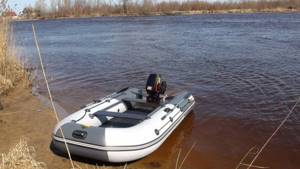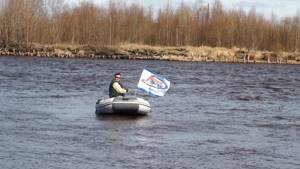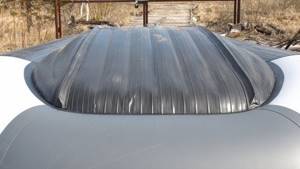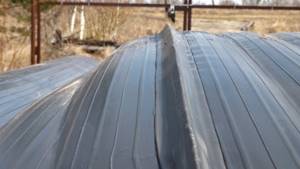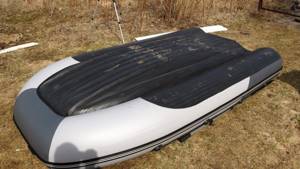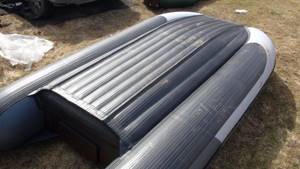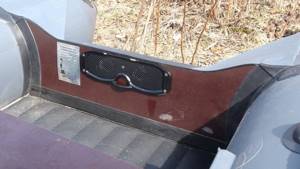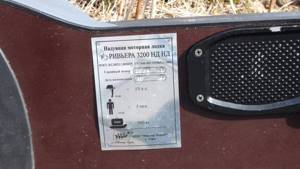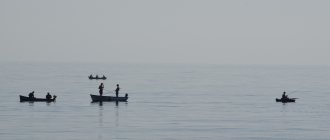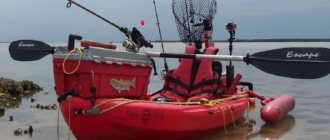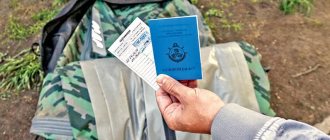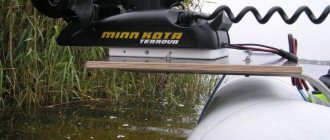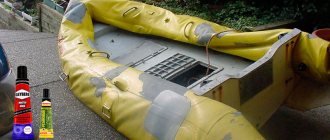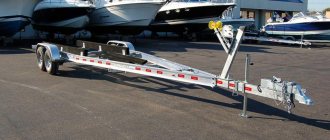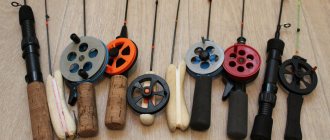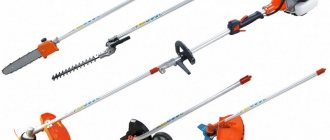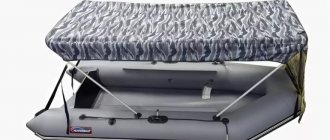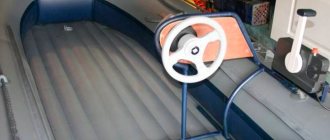Inflatable boats have long been loved by tourists, hunters and fishermen. Light weight, maneuverability, compactness - this is not a complete list of their advantages. And when choosing a specific model, buyers often come across the term “NDND boats”. What is it, is it worth purchasing such watercraft and how to choose them correctly? We'll tell you in the article.
What are NDND boats?
All inflatable boats are divided into three types:
- Payolny. In this case, the half-deck of the boat is made of plywood or aluminum. This gives additional rigidity and improves seaworthiness. The disadvantage of this type is that such a boat is more difficult and takes longer to assemble.
- AirDeck (aka NDVD). Boats of this type are similar to solder boats, but instead of plywood or aluminum, a special high-pressure inflatable liner is used. It has less rigidity and hardness than plywood, but the boat becomes much lighter and easier to assemble.
- NDND. These are boats with a completely inflatable bottom. Hardness and comfort are achieved due to the complex multi-chamber structure of the compartment-bottom.
Representative
Results
So, choosing a PVC boat for fishing and other needs is a responsible task, the solution of which will determine not only the comfort of movement, a rich catch, but also safety. In the era of marketing ratings and customized reviews, it is difficult to trust information consisting of recommendation brands. It is best to trust common logic and the experience of experienced fishermen.
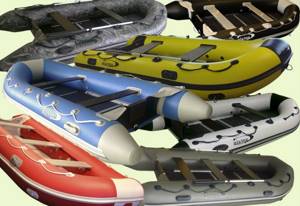
Results of choosing a PVC boat:
- When choosing a boat for a motor, focus on the size, weight and carrying capacity of the vessel. Details such as the keel and inflatable bottom will contribute to the speed of the glide.
- When purchasing a rowing boat primarily for fishing, make sure it has a reliable flooring that protects it from hooks, lures and other gear. Give preference to quickly assembled boat models with dismountable oars.
- Carefully examine the NDND boat before purchasing for the internal structure of the bottom partitions. It is best if the ND posts are sewn on.
Differences between NDVD and NDND
One of the eternal debates among amateur fishermen is: which boat to choose - with a high or low pressure bottom? We will not answer this question unequivocally, because essentially it all depends on personal preferences and needs.

To facilitate the selection process, we have prepared a comparative table with the average characteristics of LPND and LPWD boats.

Both types of boats will serve faithfully for more than 10 years (without force majeure). It’s up to you to decide which type of boat to choose. We can only say that both types of boats are quite comfortable to use.
Motor boats
Water-powered transport made of PVC is by far the most popular in the boat market.
Modern inflatable boat models with motors are highly comfortable and open to wide possibilities. How to choose a PVC boat for a motor:
- Determine the required size of the vessel. The power of the installed engine and the permitted number of passengers transported depend on the dimensions. For example, for five people you need water transport at least 4 meters long.
- Select transom type. A supporting structure is required to install the motor. There is a fixed plywood transom that is part of the inflatable, and a removable hinged transom that is glue-mounted.
- Select bottom type. Depending on personal preferences, the boat comes with an inflatable bottom of low pressure (LPND) or high pressure (HPVD); with plywood folding or collapsible floor (slan).
- Give preference to a model with a keel for stable sailing in planing mode.
- Resolve the issue of the upcoming registration of a boat with a motor in GIMS. Inflatable vessels weighing more than 200 kg and a motor with a power of 10 horsepower for a gasoline engine and 8 kW for an electric one require mandatory registration with the state inspection for small craft.
The most popular boat models are those with a low-pressure inflatable bottom and a rigid floor made of waterproof plywood.
Advantages of a motor boat with NDND:
- Increased safety due to an additional cylinder in the form of an inflatable floor;
- Improved buoyancy;
- Cushioning when rolling;
- Quick assembly by pumping;
- No contact with cold water;
- Silent movement around the cockpit.
Advantages of rigid collapsible or folding floorboard:
- Stability underfoot;
- Practicality when interacting with sharp objects in the cockpit.
Choosing an inflatable motor boat may also be accompanied by thoughts about the manufacturer, brand and price. But it is worth noting that the same technologies are used to make an inflatable boat. Manufacturing companies on the single market purchase PVC-reinforced fabric, glue and other accessories from which the boat will be created. And the warranty and approximate service life of inflatable models with similar parameters are practically the same. Therefore, when thinking about which motor boat to choose, be guided by the necessary technical parameters. Having decided on the size, transom and bottom, it will become clear how to choose the right boat; further choice is a matter of taste.
Pros and cons of NDND boats
The advantages include:
- Easy to assemble and disassemble even without special skills and alone.
- Can be transported entirely in one bag.
- Resistant to wear (compared to other types of PVC boats).
- During rolling, the boat reduces all impacts to a minimum, which ensures a “soft ride”.
- It goes very quickly on a glider due to the minimal area of contact with water.
- This boat is easy to care for - rinse with a hose or bucket and leave in the sun for a couple of hours to dry.
Interesting fact! Many fishermen use the NDND boat as an inflatable mattress for an overnight stay. It is both warm and comfortable to sleep on.
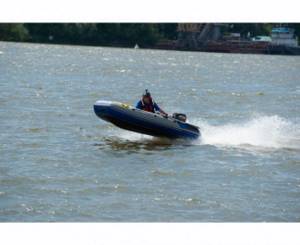
These PVC boats also have disadvantages:
- The operating area of the boat control is lower compared to other types of PVC boats.
- The inflatable bottom is unstable. You need to get used to riding a NDND boat, otherwise you can fall overboard.
- If the fisherman stands up to his full height on the boat, the center of gravity will shift and rise.
A properly selected NDND boat will serve you faithfully for many years, although you will have to “get used to” it a little first.
PVC inflatable boats

Where are inflatable boats used?
Modern motor-rowing small vessels are not inferior to rigid hulls in basic parameters. Owners do not feel disadvantaged either in terms of speed or carrying capacity. By installing the maximum permitted engine, we get an excellent adrenaline-pumping projectile - a “motorcycle”.
In inflatable motor boats made of PVC, everyone will find useful qualities for themselves.
- A novice motorboater receives his first inexpensive watercraft, which allows him to significantly expand his recreation area.
- Hunter and fisherman - a maneuverable boat that can be launched from any shore and make its way through the reeds;
- An experienced boater has a PVC boat in his arsenal for trips with a camper or without a trailer to remote, hard-to-reach bodies of water;
- The owner of a motor yacht uses an inflatable boat as a tender for trips ashore, or as an emergency raft when traveling on large bodies of water.
- “Payolki”
are good as a single or mobile set that complements a rigid body. - "Airdek"
will appeal to fishermen who do not need the drive of the maximum PLM. - The NDND
planes with a minimal motor, softens the shock of waves, and assembles quickly. Therefore, it is useful as a tender on a large boat or yacht if there is an electric pump or a shaded storage space.
Diverse in design, “inflatables” perform the function of safe movement through water thanks to several compartments (at least three) that ensure unsinkability. PVC boats are loved by motor boaters for their compactness, unpretentiousness and ease of use.
What is the difference between PVC boats
We started collecting material for the test in advance. If a review of one specimen can be sorted out within a day, then dividing several similar watercraft into groups and comparing their characteristics is not an easy task. First, let's classify the selection criteria.
Boat length
. It depends on the size of the reservoir of use, the number of passengers, the available engine, and the availability of an appropriate vehicle for transportation (usually a station wagon trunk or a utility trailer).
Payola material
. This is usually moisture-resistant plywood with Al profile edging and metal stringers. Less commonly - honeycomb light-alloy flooring, low-pressure inflatable bottom (LPND), or high-pressure inflatable bottom (Airdeck). We will leave the rack flooring of small rowing boats and the rigid aluminum or fiberglass bottom of RIBs outside the scope of the article.

Contours
. Taking into account the large width and specifics of gluing the material, we can distinguish the main types of the lower part of the body. The most common is the classic low deadrise shape with a central keelson and a moderate deadrise at the transom. Air discharge tunnels provide skegs on the cylinders for a screen effect. Inflatable bottoms range from completely flat to keeled. For extreme conditions, the bottom is reinforced (“lined”) with high molecular weight polyethylene.
Cylinder material
– PVC fabric of various densities. Hypolon is not widely used due to its high cost (the main advantage is the ability to stay under the sun for a long time). Rubberized fabric remained in the last century, as it required increased attention and care.
Method of attaching cans
- seats and attachments - hinges on cylinders, or lyctros-likpaz connection. The latter is more convenient and functional, which is why the vast majority of manufacturers have this design.
Select to compare
If we approach the issue as pedantically as possible, this test will result in a whole book dedicated to the “rubber fleet”. At the same time, it is wrong to judge all PVC boats based on a single example. Therefore, we chose one copy of the popular size 360-370 cm.
The honor of classic models was entrusted to the proven Cayman N-360. Low-pressure inflatable bottom - Badger was chosen as the flagship carrier of the airdeck, not missing the opportunity to test its modification with a metal floor.
| Model | Bottom type | Weight, kg | PLM, l/s | Ø cylinder, cm |
| Cayman N-360 | Plywood floor, 2 stringers | 70 kg (2 x 35) + stringers | 25-30 | 46 |
| Badger SL370AL | Aluminum floor, 4 stringers | 80 kg (2 x 40) | 25 | 45 |
| Badger FL360AD | Airdeck | 55 kg | 15 | 43 |
| Flagship 360U | NDND | 45 kg | 20 | 47 |
Expectations of lightness from a boat with aluminum flooring compared to plywood were not justified. The design is partly to blame for this. If in the “plywood” Cayman different materials with a density from 850 to 1150 are used for the bottom and cylinders, then the Badger is entirely made of PVC 1100 g/m².
Autumn training camps
The starting point for sailing in the “inflatable” version is assembling the boats. To compare times, we divided into teams of two and got to work.
Unloading from the car
. The classic payol design is the leader in this category, since the set is contained in two relatively small bags of approximately equal weight. Removing two 35 kg pieces is much easier on the spine than one 50 kg piece.
Spreading our wings
. When the NDND team finished deploying the shell, the “pajols” were in the process of assembling the deck and installing the stringers. The airdeck was in the middle because it didn't take long to fit a few planks in. The victory in the nomination goes to the low-pressure inflatable bottom.
Always ready!
Inflating the boats had to be done in two stages. The fact is that at first, crews with inflatable bottoms used two-stage “Bravo” compressors, and the payol ones used ordinary “frogs”. We considered the conditions of the competition unequal, and we began pumping everyone up with standard single-chamber foot pumps. The teams with the NDVD were not enthusiastic about this turn of events, and as a result they ended up in penultimate place. Because it was not possible to “fill” the airdeck to the specified pressure - the hose failed.
Good luck
. Initially, they wanted to conduct a race at maximum speed with a 25 horsepower engine. But as it turned out, models of a similar size with an inflatable bottom have lower permissible engine power. Therefore, we had to be content with the proven Yamaha-15. This PLM is still easy to carry for one person, but four people can already plane with confidence.
Separately, we note the carrying bags. Everyone liked the quality and durability of the Cayman packs, but when it comes to shelter from bad weather, Badger's waterproof fabric, despite being less durable, has an advantage.
Full speed ahead!
We tested boats with one skipper, two with a passenger on the front bank, and also with four passengers. Speed indicators are given in the table.
| Boat | 1 person | 2 people | 4 people |
| Cayman N-360 | 40 | 38 | 36 |
| Badger SL370AL | 38 | 35 | 32 |
| Badger FL360AD | 36 | 33 | 32 |
| Flagship 360U | 39 | 35 | 31 |
"Maximum speed."
All subjects performed quite well. Of course, the dynamics and speed of 48.5 km/h of the Cayman with a twenty-five-horsepower engine were far from it, but, nevertheless, the participants coped with the task. Since the purpose of testing was not a fundamental study of the class of vessels, but an assessment of the totality of consumer qualities, we did not carry out accurate measurements of pressure in the cylinders and the location of the riders. Although the experiment with loading the K-360 showed a very significant effect of changing weight distribution on speed.
Timing.
Assembling the version with floorplates will take no more than thirty minutes. It will take about an hour to disassemble, wash and wipe the structure after fishing. In this regard, NDND has an advantage. You will spend half as much time on assembly and disassembly.
Peculiarities.
Speaking about Airdeck, we note the need to purchase an electric pump. Pumping up the bottom with a standard “frog” is an activity for the diligent. Even with rated pressure, at speeds above 30 km/h, the airdeck flexes slightly, which prevents the vessel from achieving maximum performance. The same applies to full load. You should also not exceed the engine power, nor should you get carried away with four-stroke engines.
Impression.
The low pressure bottom was surprisingly positive. It turned out to be quite tough, people stood confidently. But it is advisable to cover it with carpet from falling cigarette butts, knives, and also from the scorching sun.
Maintainability.
Volumetric bottoms, unlike payol bottoms, are practically not subject to repair. When at least a few connections between the top and bottom of the “sandwich” break in a hull left in the sun, the deck will turn into a shapeless “sausage.” And if the airdeck can be replaced with plywood or aluminum flooring, then the NDND is an integral part of the structure. It is worth remembering this when leaving a watercraft on the beach or deck of a yacht.
Let's sum it up
In general, this test confirmed the different purposes of the subjects.
We wish our readers calm waters, new adventures, and reliable boats.
How to choose a boat with NDND
If you are determined to purchase a boat with NDND, then you need to pay attention to several parameters - the strength of the material, the size of the boat and the color. Let's talk about everything in order.
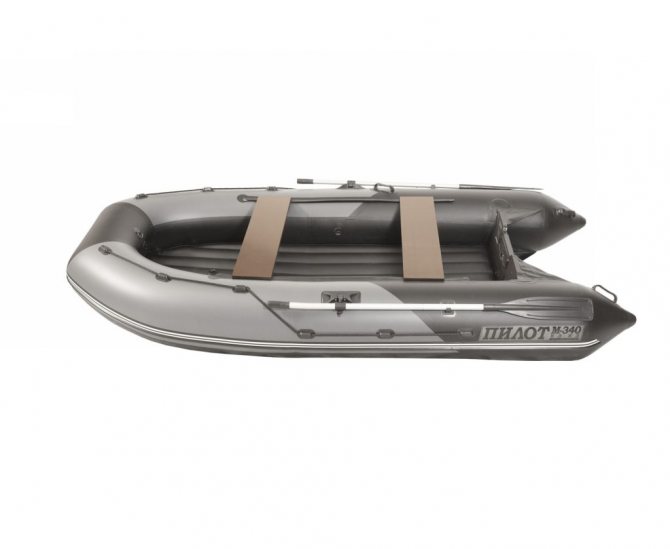
Material NDND boats
Here the principle will be simple - the stronger, the better. Especially if you purchase a single-seat model, or will fish/hunt alone. If a puncture or hole occurs and there is no one to help, this will increase the risks.
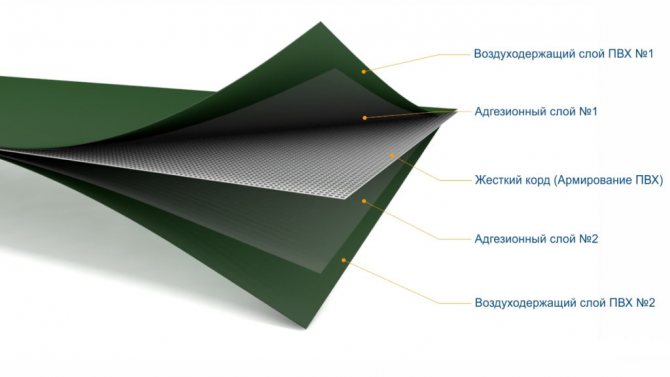
The best option for a single-seater boat is reinforced PVC fabric. It consists of five durable layers and it is very, very difficult to pierce or puncture this fabric.
Dimensions of NDND boats
It all depends on the number of seats. Optimal sizes for:
- Single – 2.7-3.3m;
- Double – 3.3-4.2m;
- Triple (or more) – from 4.2 m.
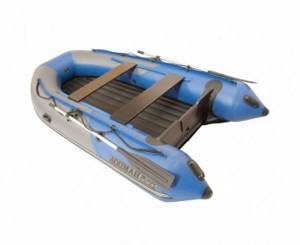
When looking at different options, consider not only the length of the boat, but also the cylinders. They affect both weight and comfort of swimming.
Color NDND boats
For the most part, it's a matter of taste. But it is worth remembering that if you are hunting, color affects camouflage. Since hunting is often done in the summer, you need to choose green shades of PVC or khaki.
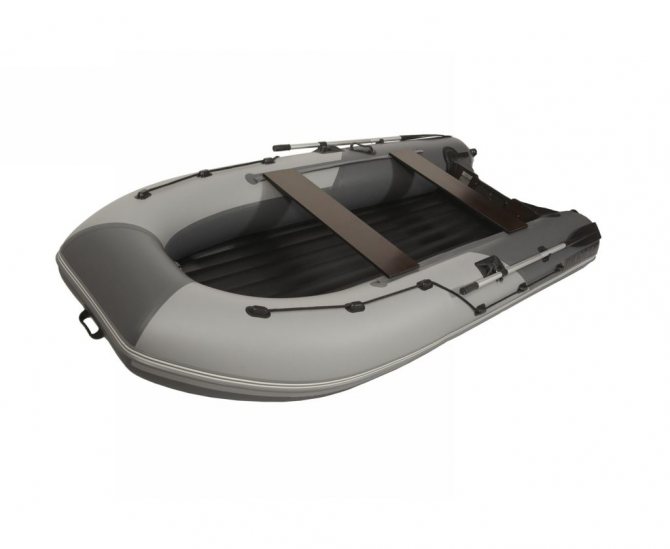
For fishing, you should choose light-colored boats. There is an opinion among fishermen that in hot weather the boat heats up, the pressure in the cylinders increases and this can lead to an explosion. Light color is safer.
For tourism, color does not matter.
A little history - low pressure inflatable bottom NDND
This material appeared completely by accident. While preparing a report on the test drive of the Riviera 3200 NDND boat, I decided to delve into the history of the low-pressure inflatable bottom as a separate and independent type of floor on inflatable boats. And the result was a separate article.
The first attempts to install such a floor were made in those distant and blessed times when inflatable boats were made not from PVC fabric, but from rubber. Moreover, most likely the first were not even enterprises specializing in the production of boats, but their owners themselves. This was done simply - an inflatable mattress, also made of rubber, was placed on the bottom of the boat. At the dawn of my adolescence, which coincided with the years of perestroika, I still saw these marvelous combinations on the water. Then, much later, already in the 90s of the twentieth century, built-in NDND appeared on some models of Ufimok and Nyrkov. Moreover, in parallel, the process of producing native “factory” inflatable rubber inserts for the then produced rubber inflatable boats was mastered.
The installation of this type of floor on rubber rowing boats was justified by the fact that being in a boat with an inflatable floor was much more pleasant than without it. Especially in early spring or late autumn - when no amount of woolen socks or felt insoles in rubber boots can save you from the cold that lingers from the water. But the era of rubber boats (and this was precisely the era in which several generations of fishermen, hunters and tourists lived) came to an end and was smoothly replaced by the era of inflatable boats made of PVC fabric. The first attempts to install NDND on inflatable boats made of PVC fabric were made in the same way and using the same methods as on rubber boats - that is, at first they were installed exclusively on rowing boat models. Moreover, just as in the first case, the boats had both a built-in inflatable floor and separate inflatable inserts like a mattress, but made of PVC fabric. But modern transom inflatable boats are, first of all, full-fledged small vessels designed for use with outboard motors. And quite powerful. But in the segment of motor inflatable boats, for a very long time, a hard bottom made of marine plywood with stringers completely and undividedly reigned. Which was considered the most reliable and appropriate for installation on boats measuring 3 meters or more in length, although in fact the technology and production culture of many domestic manufacturers simply did not allow them to offer anything else. But the idea of an inflatable bottom for a motorized inflatable boat did not leave the minds of manufacturers and experiments continued to be carried out. Although it should be noted that at the time when our domestic manufacturers were working on a low-pressure inflatable bottom, a fundamentally new type of floor for inflatable boats appeared in the West - a high-pressure inflatable bottom (HPVD or Air-deck). This technology allows you to inflate an inflatable insert installed in the cockpit of a boat to almost the hardness of plywood and obtain a flat, hard floor of the boat without additional effort. But, nevertheless, this technology has both its advantages and disadvantages, which we will talk about another time. Now let's return to NDND. In search of new solutions, conceptually new models of inflatable boats with NDND were created, some of which were both good and different. An interesting solution was the creation of an inflatable catamaran with NDND, but at the same time, “miscellaneous” include attempts to put into mass production boat models, the use of which on the water was a source of potential danger to both the health and life of its owner.
In the process of working on the creation of NDND for inflatable motor boats, the concept itself and the rationale for its production acquired a significant change. So, if earlier its main task was to separate the human body from the cold of the water with an additional air cushion, then in the modern understanding, the use of an inflatable bottom on boats serves to reduce their weight and increase the ease of assembling the boat. As mentioned above, the first serious motor inflatable boats made of PVC were equipped with plywood floors, which were securely fixed in the assembled state with metal stringers. The design is reliable, time-tested and, most importantly, it allows you to get a flat, hard floor inside the boat’s cockpit, on which you can not only cast with a spinning rod, but also, if desired, dance the ancient sailor dance jig. But despite its advantages, the paul floor also has its disadvantages, namely, it accounts for most of the total weight of the boat, and assembling and disassembling a hard floor with stringers on large boats is a very dubious pleasure. Especially in spring and autumn, when PVC fabric loses its elasticity at low temperatures and, until you finish assembling and disassembling the boat, you no longer want to go fishing. By the way, it is this fact that forces many owners of inflatable boats to transport them on trailers already assembled throughout the season. The use of an inflatable bottom solves all these problems at once. You can bring an inflatable boat with an LPND of any size into working condition using an electric pump in an average of 15-20 minutes. Moreover, by the efforts of one person, who only needs to move the electric pump hose from valve to valve in time and install the oars and cans. That is, much less time and effort is spent on assembling and disassembling such a boat. The same is with the weight - it is several times less, which means that it is much easier to carry and transport such a boat than a deck boat. But using boats with NDND also has its pitfalls. At first, manufacturers tried to make them with a convex bottom simulating deadrise, which made the boats a little rolly on the water and unstable while moving. Also, during operation, another interesting feature of these ships was revealed - they learned how to make an inflatable bottom, but its repair became a real headache for many. Since often even the manufacturer himself refused to repair the damaged inflatable bottom of even his boat. But over time, this problem was solved, and today inflatable motor boats with NDND are beginning to enjoy increasing popularity among motor boaters. Especially for those who already have experience with inflatable boats with a hard floor. And the NDND solutions offered by different manufacturers can serve as the basis for separating such inflatable motor boats into a separate class of small boats.
|
|
|
|
|
|
|
|
All inflatable motor boats with NDND presented in the Lodki-Piter chain of stores have undergone internal testing and are recognized by our specialists as seaworthy, reliable and safe for use.
The service can also carry out repairs and tuning of boats with NDND of any degree of complexity. Pavel Prudnikov Boats-Peter Return to list
Summarize
So, NDND boats - what is it? This is a low pressure inflatable floor. It is either removable or integrated. Traditionally, such a bottom consists of separate compartments, which are gradually filled with air.
Such boats are easy to inflate even when alone, they fit in one bag and are characterized by high wear resistance and thermal insulation. They are also very easy to wash and will not feel the impact of small waves.
You need to select a NDND boat for purchase, first of all, based on your plans. For fishing, it is recommended to choose a boat of light colors, for hunting - green or khaki. It is also important to pay attention to the size of the vessel, and not skimp on durable materials for a single-seater boat.
Question answer
Question: How to understand the NDND of a boat and what is it?
Name: Ildar
Answer: NDND boats are vessels with a low-pressure inflatable bottom. That is, the boat does not have an ordinary thin floor, but something that needs to be inflated, just like the sides. The bottom is inflated separately and can be divided into compartments, which are also inflated separately.
Question: Boats NDND what does this always mean?
Name: Tagir
Answer: LPND stands for low pressure inflatable bottom. There is also a high-pressure inflatable bottom.
Question: What is the difference between a PVC boat and the NDND designation?
Name: Alexey
Answer: NDND is a characteristic of the bottom of inflatable boats. PVC boat is classified as an inflatable boat. That is, you can buy a PVC boat with a regular bottom or with a low-pressure bottom (also with low-pressure water).
Share link:
Design features and technical properties of NDND boats
Each boat-type transport, be it aluminum, rubber or PVC motor boats with a hard or inflatable bottom, has its own characteristics. And the NDND inflatable boat, of course, is primarily structurally different in its bottom. The low-pressure inflatable bottom is made of a separate sealed compartment and has the following features:
- For the bottom, two-layer PVC fabric with a density of 400 to 1100 g/m2 is used.
- Increased structural strength is ensured by welding longitudinal seams.
- The presence of one or two valves for bleeding air (including on the go).
- Fenced sections of different sizes, ensuring rigidity and deadrise of the structure.
Accordingly, the properties of the bottom largely determine the pros and cons of the craft. Let's look at how PVC boats with a low-pressure bottom (LPND) differ in this regard.
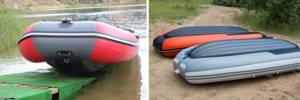
Advantages
Manufacturers, and most importantly active users, note the following advantages characteristic of a PVC NDND boat.
- Ease and speed of assembly/disassembly. To get on the water, you just need to pump the watercraft with air. When working with a mechanical pump, assembly will take 10-15 minutes, and an electric pump will cope with this task in 5-7 minutes. For comparison, assembling a floor with a profile or stringers takes about half an hour.
- Smooth running with reduced vibration. A boat with a low-pressure inflatable bottom is less susceptible to wave impacts, which reduces the level of vibration of the craft. When traveling on short waves on such a vessel, passengers are much more comfortable than on a boat with a hard floor, which, on the contrary, increases the “shaking”.
- Motor speed and use. Thanks to the convex bottom, the speed of a vessel with NDND is higher than that of boats with a rigid floor. Accordingly, motor boats with a low-pressure inflatable bottom can be equipped with low-power engines, while still showing decent speed qualities. In addition, engines of lower power are lightweight, which is important for small-sized PVC vessels.
- Planing. As already noted, the NDND design gives the hull a deadrise. Such a boat planes better, because... touches the water only with its convex bottom. By the way, the small contact area also reduces the amount of splashes raised, and the hull of the vessel remains dry.
- Increased load capacity. Due to their design features, PVC inflatable boats with an inflatable bottom are capable of carrying more weight than vessels with a rigid bottom, although the dimensions of the craft are identical.
- Wear resistance and thermal insulation. The removable edges of the floor abrade the inner sides of the cylinders, but with an inflatable floor this problem does not arise. In addition, PVC fabric itself wears out less than plywood flooring. It is also worth noting that inflatable floors conduct and retain heat better, so if necessary, you can even sleep comfortably in a boat and not freeze. The same cannot be said about plywood: sleeping on hard flooring will require an additional mattress.
- Easy to care for. To wash off dirt, fish scales, bait crumbs, etc. from the cockpit after fishing, just pour a few buckets of water onto the deck. At the same time, the vessel will dry out very quickly, because... NDND material is water-repellent. And hard flooring will have to be washed separately and dried much longer.
- Safety. And finally, a motor or rowing boat with an inflatable bottom has a hidden “trump card”: punctures in the hull do not affect the air pressure in the bottom, because it is a separate compartment. Thus, in the event of an emergency, the bottom will keep the boat afloat and allow the fisherman to reach the shore, essentially using the inflatable bottom as a mattress or raft.
You might be interested: Steering for a boat - types and design of consoles, installation
It is also worth noting that such watercraft are also inexpensive: NDND boats cost about the same as regular PVC ones. Accordingly, other things being equal, sometimes it makes sense to give preference to an inflatable bottom. However, it also has disadvantages and should be discussed in more detail.
Flaws
Among the inconveniences faced by owners of boats with low-pressure inflatable bottoms, the following qualities should be noted.
- Insufficient rigidity. Compared to plywood or plastic decking, boats with inflatable bottoms provide less stability. To maintain balance when rising to full height, passengers have to make some effort.
- Reduced cockpit dimensions . An inflatable floor is tall and requires more space than a flat floor.
- Landing above the water level overboard . As a result, there are slight problems with stability and center of gravity distribution. Particular care must be taken to distribute the load on the keel inflatable bottom of the PVC boat up to 3 meters. If there is not enough weight in the front of the hull, the bow of the boat will rise and bounce on the wave, worsening the performance of the vessel.
- Slippery deck. When a large amount of water gets on the PVC material, a “sliding” effect appears. Therefore, it is recommended to purchase special non-slip mats for the inflatable floor.
- Inconvenient tiller position. The transom of a PVC boat with an inflatable bottom is too low, and during long passages it becomes difficult to steer the boat with a low tiller.
- Transportation difficulties. To carry a regular PVC boat, 2 bags are usually used (one under the hull and the other under the hard bottom), and the NDND boat is assembled into one bag. Such packaging turns out to be much heavier and larger in size, so it is more difficult to move a folded vessel with an inflatable bottom.
- Vulnerability to damage. Pitfalls, snags and reeds interfere with the safe operation of the vessel, because... the bottom is highly vulnerable to punctures. Therefore, owners often strengthen the outer surface of the bottom themselves, but this will require additional financial costs. However, even if a breakdown of the bottom can be corrected, it will only be through expensive repairs.
This is what the pros and cons of a PVC boat with NDND objectively look like. It’s hard to say whether it’s better than a regular vessel with a hard floor or worse, because... this is an individual decision. If your prerogative is long hikes in different bodies of water and fishing while standing, then it is better to give preference to a watercraft with a hard flooring. If you need a small boat with fast gliding and a large carrying capacity, then you should choose NDND. We’ll tell you in detail how to make the right choice of the appropriate model, but a little later. So far, one more design point remains unclear.
Differences between NDND and NDVD boats
When you come to the store or choose a watercraft on the website, you will see that along with the NDND there is an inflatable boat NDVD. This abbreviation means that the boat is equipped with a High Pressure Inflatable Bottom. This design differs from the low-pressure bottom in several ways:
- Increased density of the material (two-layer PVC 1100 g/m2 thick);
- Air pressure 0.4 - 0.8 atm;
- Pumping is possible only with an electronic compressor;
- Improved properties (the body is able to soften the impacts of not only short, but also medium waves).
As a result, a vessel with low-pressure water pressure has greater bottom rigidity, high reliability and increased stability. However, the cost of boats with a high-pressure bottom is much higher than that of vessels with a low-pressure bottom, so the latter are more popular and in demand.
You may be interested in: How to choose a trailer for a boat or yacht, as well as their varieties, popular models and prices
